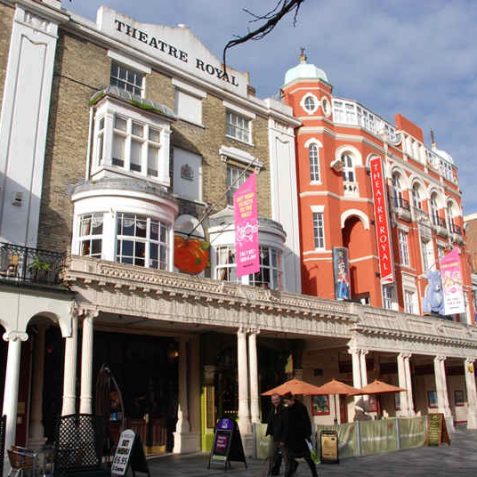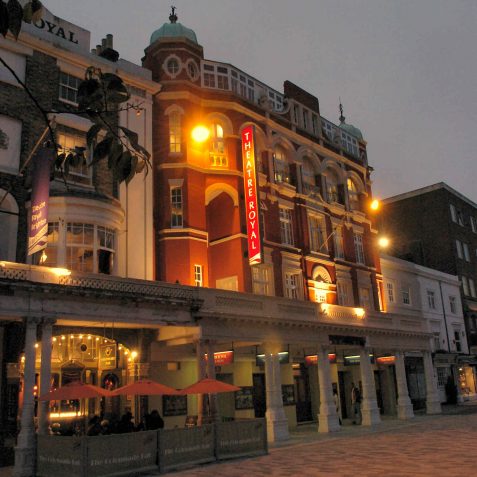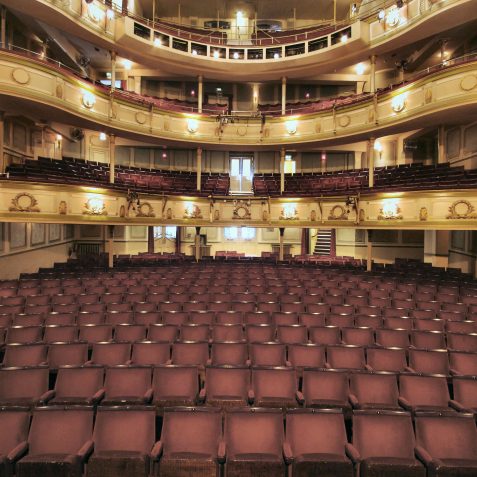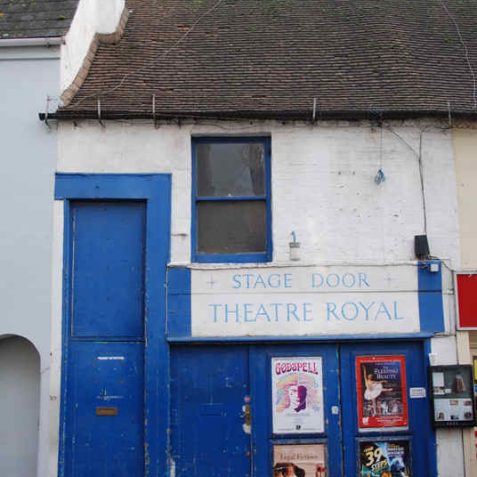Fluctuating fortunes with eventual success
Please note that this text is an extract from a reference work written in 1990. As a result, some of the content may not reflect recent research, changes and events.
c) REBUILDING: The Theatre Royal was again rebuilt in 1894 by C.E.Clayton after improvements were demanded by the corporation on safety grounds. No.9 New Road was incorporated as the principal entrance and box-office, and a dress-circle bar was added on the first floor with offices on the second. The colonnade was rebuilt outside nos.9-12, while the facade of nos.11-12, the original theatre building, was completely rebuilt above the colonnade in its present form, red brick and terracotta with two octagonal turrets at the corners. Nos.35-38 Bond Street were acquired and no.35 was converted into a new stage door, but the others were resold in 1934. With the replacement of gas-lighting by electrical, the theatre reopened on 1 September 1894 at a cost of £14,000.
The theatre operated quite profitably under managers H.Cecil Beryll and Robert Lawson Lambert, and was redecorated in 1904, 1909, and in 1912 when individual seats and a new heating system were installed. Performances continued throughout the First World War, and more seats were added and other alterations made in 1927.
FALL AND RISE: However, with the depression of the 1930s and competition from ‘talkie’ cinemas and other theatres, the Theatre Royal was operating at a loss by 1934 and was forced to close for four weeks. J.Baxter Somerville took over as manager in 1936 and performances continued almost throughout the war , but attendances were poor and the shoestring budget often forced Somerville to take no wages. After 1945 Somerville was again able to put on some fine productions including many pre-London runs, and the Theatre Royal’s reputation was re-established. In 1961 the company was reformed with Lewis Cohen as chairman, but J.B.Somerville died on 19 January 1963 and was greatly mourned. Since that time there have been few alterations to the building, which now seats 952 people and is listed, but the Theatre Royal, which was sold for around £250,000 in December 1971, maintains its reputation as one of the country’s leading provincial theatres.
Any numerical cross-references in the text above refer to resources in the Sources and Bibliography section of the Encyclopaedia of Brighton by Tim Carder.








Comments about this page
On Friday the 22nd November 1963 my wife and I were at an evening performance of ‘Doctor in the House’ at the Theatre Royal when the curtains abruptly closed and the Theatre Manager came on stage to announce that John Fitzgerald Kennedy, the thirty-fifth President of the United States, had been assassinated in Dallas, Texas. It’s said that there are certain events in everyone’s lives that they never forget and that is certainly true in this particular case. Ian Hunt (Alberta, Canada)
My favourite theatrical story is of being at the pre London performances of Harold Pinter’s Homecoming when a woman in the same row as me got up and pushed past us all declaring she hadn’t come to the theatre to hear language. As a working class lad from a secondary modern school the Theatre Royal was Valhalla.
From 1926 to 1928 my grandfather Lawrie Sargeant ran The Colonnade bar at The Theatre Royal. Apparently this is the only place in the country where there is a completely separate pub within the foyer of a theatre. The family arrived there just in time for the General Strike and lived above the premises. My father Carl (b1912) used to recall climbing onto a roof at the back from where you could see into the actresses dressing rooms! He also went across to the Corn Exchange to watch John Logie Baird give a demonstration of his new ‘Televisor’ machine. Many actors were skint in those days and grandfather would often advance them a bit of cash or purchase items from them. A few of these bits and pieces we still have. The Colonnade is still serving audiences today.
Add a comment about this page